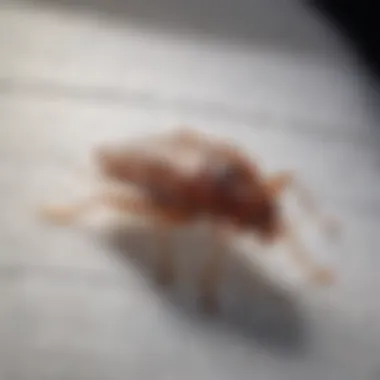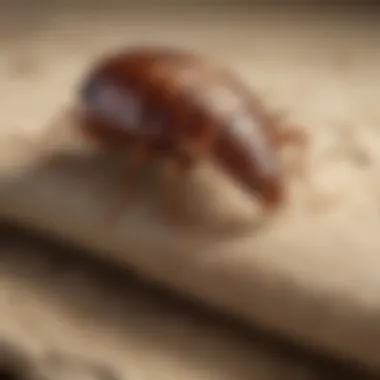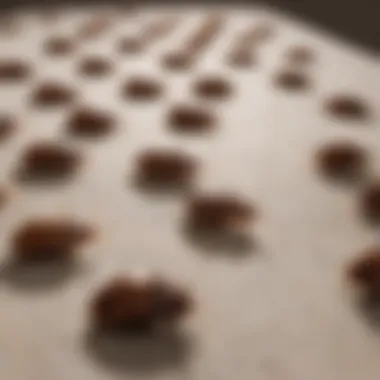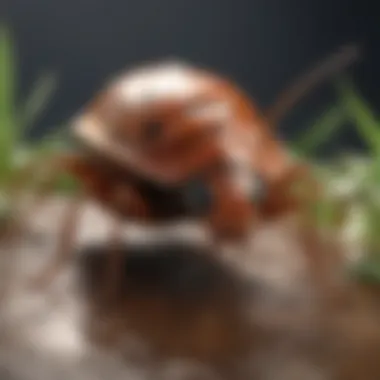The Implications of Finding One Bed Bug: An In-Depth Analysis


Intro
The discovery of a single bed bug can raise immediate concerns for any homeowner. Understanding its implications is essential, not just for peace of mind, but also for effective pest management. This article explores various facets of finding a bed bug, including its biological traits, signs of possible infestations, as well as prevention and control strategies.
Pest Identification
Identifying pests correctly is the first step in managing them effectively. Bed bugs belong to the Cimex lectularius species and can easily be mistaken for other insects.
Common Household Pests
In addition to bed bugs, many pests could invade a home, including:
- Ants
- Cockroaches
- Mice
Each pest has unique traits. Bed bugs are small, about the size of an apple seed, reddish-brown in color, and flat. Their shape and size can complicate initial identifications.
Signs of Infestation
Early detection of bed bugs involves looking for several indicators, such as:
- Small blood stains on bedding
- Dark spots or fecal matter on sheets or mattresses
- Molted skins left behind during growth
- A musty odor
These signs can provide crucial insight into the presence of not just one, but possibly many more bed bugs. Ignoring a single bed bug can lead to a more extensive infestation.
Prevention Methods
Prevention is the most effective method to combat bed bugs. Knowledge and action can reduce the likelihood of an infestation dramatically.
Environmental Modifications
Making certain changes in your home can deter bed bugs from taking hold. Some suggestions include:
- Regular cleaning and vacuuming
- Using bed bug encasements on mattresses and pillows
- Decluttering to reduce hiding spaces
Home Maintenance Tips
Additionally, regular maintenance is vital. Keeping an eye on your living conditions can prevent future encounters.
- Seal cracks and crevices
- Repair any damaged furniture or structures
- Inspect secondhand items before bringing them into your home
Implementing these adjustments can decrease risk significantly.
DIY Pest Control Solutions
For those keen on managing pest issues independently, various methods can be employed.
Natural Remedies
Several natural options exist for eliminating bed bugs. Some alternatives include:
- Diatomaceous earth
- Essential oils, such as tea tree oil or lavender
- Alcohol-based sprays
While these methods may not be foolproof, they can help in reducing bed bug populations.
DIY Traps and Barriers
Creating traps can be an effective way to monitor and control bed bugs. Simple solutions include:
- Placing sticky traps near beds
- Using double-sided tape on bed legs
These traps function to catch wandering bugs and help keep track of their activity.
Immediate action is crucial when spotting bed bugs, as their rapid reproduction can lead to extensive infestations.
By gaining a deeper understanding of bed bug behaviors and implementing proactive measures, homeowners can navigate the complexities associated with these pests more effectively.


Prolusion to Bed Bugs
Understanding the intricacies surrounding bed bugs is critical, especially when the uninviting discovery of a single specimen occurs. This rising concern among home owners and housewives can trigger immediate panic, igniting questions about the severity of the situation.
An acquaintance with bed bugs contributes to informed decision-making and prevention techniques, which can save time and resources. This section will elucidate the significance of subterranean wisdom about bed bugs, thereby equipping individuals with the knowledge to navigate their potential presence.
Understanding Bed Bugs
Bed bugs, scientifically known as Cimex lectularius, are small, oval-shaped insects that thrive in human dwellings. They have a penchant for nocturnal habits, typically lurking in crevices and awaiting their opportunity to feed on blood during the night.
Their small size, coupled with agile movements, often contributes to unnoticed infestations during the early stages. Commonly associated with travel, they can hitch rides in luggage, clothing, and even bedding. It is crucial to realize that their presence does not necessarily signify poor hygiene. Instead, bed bugs may enter any environment, irrespective of cleanliness levels. This fact alone highlights the necessity of recognizing their characteristics for effective control.
Biology and Lifecycle
Bed bugs follow a distinct lifecycle, consisting of several stages: egg, nymph, and adult. An adult female bed bug can lay anywhere from one to five eggs daily, leading to exponential population increases if left unchecked.
Eggs are approximately 1 millimeter long and white, making them particularly hard to spot. The nymphs emerge from the eggs after about a week, progressing through five nymphal stages before reaching maturity, which can occur within a month in optimal conditions.
Their lifecycle is profoundly influenced by temperature, as they thrive in warm environments. Research indicates that bed bugs can survive for months without a meal, making eradication quite challenging.
In summary, understanding bed bugs' biology and lifecycle provides critical insights into why a single bed bug should not be taken lightly. Immediate action upon discovery can prevent an escalation from a seemingly isolated encounter to a comprehensive infestation.
"Identify early signs of infestation to effectively mitigate the risk of bed bugs soon becoming an unwanted household presence."
This knowledge not only empowers households but also fosters a proactive approach to eradication and prevention.
The Significance of Seeing One Bed Bug
Seeing one bed bug in your home can trigger various reactions, both emotional and practical. It is crucial to address this finding thoughtfully. Understanding the significance of this singular discovery can help in making informed decisions about pest management.
Initial Reactions and Misconceptions
When an individual discovers a bed bug, the response can be one of shock, fear, or even denial. Many people may assume that finding a single bed bug indicates a widespread infestation. This misconception often leads to panic. However, spotting just one bed bug does not always mean your home is overrun by these pests.
The initial reaction can cause people to overlook key signs of an infestation. Instead of acting rapidly, they might dismiss the encounter, thinking it was a stray insect that wandered in. This reaction could delay addressing the problem, making it worse in the future. Immediate recognition and understanding of bed bugs are critical for effective management. To avoid misconceptions, one should educate themselves about bed bug behavior and characteristics.
"Knowledge is power when it comes to handling pest control."
Understanding Infestation Levels
In assessing an infestation level, context is essential. Finding one bed bug may be just the tip of the iceberg or a singular occurrence. Bed bugs reproduce rapidly; thus, understanding their reproductive cycle is vital. A single adult bed bug can lay hundreds of eggs in its lifetime. If left unchecked, what begins as an isolated bug can escalate to a significant problem.
To determine if your home is dealing with an infestation, consider the following factors:
- Location of Discovery: Where was the bed bug found? Common areas of bed bug activity include beds, furniture seams, and box springs. Finding it in these locations suggests a higher likelihood of a larger issue.
- Search for Additional Signs: Look for other indicators such as small, dark spots on bed linens, discarded skins, or tiny white eggs. These signs can help clarify the level of the infestation.
- Time: Consider how long the bed bug has been present. A recent discovery likely indicates a lower level of infestation compared to one found after a prolonged period.
By examining these elements, homeowners can better understand whether one bed bug is an anomaly or a signal of a larger problem. Knowledge of infestation levels empowers residents to take appropriate and timely action.
Identifying Bed Bug Presence
Identifying the presence of bed bugs is crucial for homeowners and anyone managing a living space. These pests can multiply quickly, leading to significant infestations if not addressed early. Recognizing their signs allows for quick action, which can save time, money, and stress.
Common Signs of Infestation
There are several common indicators that suggest the presence of bed bugs. First, one should look for the actual bugs themselves, which are small, reddish-brown, and often hidden in seams of mattresses, bed frames, and even behind wallpaper.
Other notable signs include:
- Bite Marks: Bed bug bites may appear as clusters on the skin, often swollen and itchy.
- Blood Stains: Small blood spots on linens or mattresses may indicate bed bugs have been feeding.
- Fecal Spots: Dark brown or black specks may be found on sheets or in the creases of beds and furniture; these are fecal matter from the bugs.
- Eggs and Shells: Finding tiny, pearly eggs or yellowish shells can indicate an active population.
"Awareness of these signs enables immediate action, reducing the likelihood of widespread infestation."
It is essential for homeowners to regularly inspect their living spaces, especially after travel, as this is a common way for bed bugs to be introduced.
Differentiating Bed Bugs from Other Pests
Not all pests are bed bugs, and misidentifying them can lead to ineffective management strategies. Bed bugs are often confused with other insects, such as fleas or cockroaches. Here are key differences:


- Size and Color: Bed bugs are flat and oval, measuring about 1/4 inch in length, while fleas are smaller and more agile, and cockroaches are much larger and darker in appearance.
- Life Cycle: Bed bugs are known for their distinct lifecycle stages and specially designed for hiding. Fleas jump and are usually found on pets.
- Feeding Habits: Bed bugs feed exclusively on blood, primarily during nighttime. Cockroaches are scavengers, and fleas usually feed on pets.
By being informed about these distinguishing factors, homeowners can better assess the situation and determine the right course of action. Understanding the specific traits of bed bugs will lead to more effective identification, which is critical for successful pest control efforts.
Reproductive Behavior of Bed Bugs
Understanding the reproductive behavior of bed bugs is crucial in comprehending their potential to infest a living space. Bed bugs have unique mating and egg-laying patterns that greatly influence their population growth. Recognizing these behaviors can assist individuals in managing infestations effectively or taking preventative measures.
Mating and Egg-Laying Patterns
Bed bugs exhibit distinct mating rituals. The process begins when a male bed bug seeks out a female for mating. One notable aspect of their mating behavior is known as traumatic insemination. The male bed bug pierces the female's abdomen with his genitalia, introducing sperm directly into her body cavity. This method is not only unusual but also reinforces the idea that bed bugs can reproduce in ways that may not be immediately apparent to homeowners.
Once mating occurs, a female can lay several eggs daily, averaging about one to five eggs per day. A single female can produce hundreds of eggs in her lifetime. The eggs, often laid in hidden locations, are sticky and can adhere to surfaces, making them difficult to detect. Knowing how many eggs a female can lay emphasizes the urgency of taking action upon discovering even one bed bug.
Impact of Temperature on Reproduction
Temperature plays a significant role in the reproductive cycle of bed bugs. The ideal temperature range for reproduction is between 70°F and 80°F (around 21°C to 27°C). Within this range, the metabolic rates of bed bugs increase, resulting in faster growth and reproduction. Conversely, temperatures below 60°F (approximately 15.5°C) can slow their development significantly.
Heat is often employed as a method of pest control, but it's essential to understand the exact temperature necessary to effectively eliminate bed bugs. For instance, heating a room to 118°F (about 48°C) for an extended period can kill all life stages of bed bugs, including eggs. By understanding how temperature influences bed bug reproduction, homeowners can implement more effective management strategies.
"Recognizing the reproductive habits of bed bugs enhances our ability to contain an infestation before it escalates. Immediate action can make a significant difference in controlling their population."
In summary, the reproductive behavior of bed bugs is a fundamental aspect that informs their potential for population growth. Understanding their mating rituals and how temperature affects reproduction provides valuable insight for effective pest management.
Effective Management Strategies
Managing the discovery of a bed bug is crucial for maintaining a pest-free home. Effective management strategies help prevent further infestations and protect your living space. When you find even a single bed bug, understanding the management process is essential. This section highlights immediate actions to take, DIY pest control techniques, and guidance on when to engage professional services.
Immediate Actions to Take After Discovery
Once you spot a bed bug, it is vital to act quickly. Here are some immediate steps to ensure the situation does not worsen:
- Capture the Bug: Use a piece of tape to capture the bed bug without squishing it. This prevents any pheromone release that could attract more bed bugs.
- Isolate Infested Items: If you find the insect on clothing or bedding, isolate these items immediately. Place them in sealed plastic bags to prevent spread.
- Clean the Area: Thoroughly vacuum the area where the bed bug was found. Pay special attention to crevices, seams of furniture, and edges of the carpet. Dispose of the vacuum bag outside your home.
"Timely actions can greatly reduce the potential for a severe infestation."
DIY Pest Control Approaches
For those inclined to tackle the issue on their own, several DIY pest control approaches can be effective. Here are some methods to consider:
- Heat Treatment: Bed bugs cannot survive temperatures above 120°F. Consider washing infested textiles in hot water and drying them on high heat.
- Insecticidal Sprays: There are various commercial bug sprays formulated specifically for bed bugs. Ensure you follow the instructions carefully to use them safely.
- Diatomaceous Earth: This natural powder can be sprinkled around areas where bed bugs may hide. It works by dehydrating the insects that come into contact with it.
These methods can help manage minor infestations. However, their success relies heavily on thorough application and consistency.
When to Call Professionals
While DIY approaches have their benefits, certain situations warrant professional help. Here are signs indicating it may be time to seek expert assistance:
- Persistent Infestation: If you continue to see signs of bed bugs despite your efforts, it may be a sign of a more severe infestation.
- Lack of Experience with Pest Control: If you are unsure about applying any treatment effectively or safely, professionals have the expertise.
- Health Concerns: If anyone in your home has a history of allergic reactions or serious health issues, immediate professional intervention is advisable.
Involving pest control experts can save time and stress, often resulting in a more thorough treatment than DIY methods can provide.
Myths Versus Realities
The topic of myths versus realities concerning bed bugs is crucial for comprehending the true implications when one is found. There are many misconceptions about these pests, often leading to panic, misguided actions, or inadequate responses. Misunderstandings can inhibit effective management and cause unnecessary distress for homeowners. Recognizing factual information about bed bugs, supported by scientific evidence, can empower individuals with decisive knowledge.
By understanding the myths, one can differentiate between what is exaggerated or false, and what is based on observations and studies. This section aims to clarify these disparities, allowing readers to make informed decisions and take appropriate action when faced with a potential bed bug issue.
Common Myths About Bed Bugs
Many myths surround the presence of bed bugs. Some of the more prevalent ones include:
- Bed bugs are only found in beds: This is untrue; they can inhabit various locations, such as furniture, carpets, and even behind baseboards.
- Only dirty homes get bed bugs: Cleanliness is not a deterrent for bed bugs. They can infest any environment, regardless of hygiene practices.
- Bed bugs carry diseases: Clinical evidence shows that while bed bugs cause discomfort and distress through bites, they do not transmit diseases to humans, unlike some other pests.
- One bed bug means an infestation: Spotting a single bed bug does not necessarily indicate a widespread problem, but it is always a cause for concern and vigilance.
These misconceptions often lead homeowners astray, leading to ineffective or unnecessary measures that fail to solve the underlying issue.


Scientific Evidence and Truths
Scientific research provides a solid foundation to debunk common myths about bed bugs. For instance, studies indicate that bed bugs are adept migrators capable of traveling considerable distances to find a host. They do not solely rely on infesting beds. Their resilience, ability to survive long periods without feeding, and adaptive behaviors contribute to their spread.
Further, extensive research confirms that bed bugs do not spread pathogens. The lack of evidence regarding disease transmission is a critical truth for individuals who worry excessively about health risks from bed bug encounters. Understanding the biology and behavior of these pests can guide better management practices.
In summary, acknowledging scientific truths helps to demystify bed bugs, transforming fear into informed action. This empowers homeowners to effectively address any signs of bed bug presence without succumbing to unjustified fears. Emphasizing facts over myths can lead to more effective pest management strategies, reducing anxiety and improving prevention efforts.
Prevention Techniques
The importance of prevention techniques cannot be understated in the context of bed bugs. Preventing an infestation is often a far less complex task than eradication once bed bugs have established a foothold. Understanding the various prevention strategies allows homeowners to maintain a clean and secure environment. Successful prevention will save time and resources, and mitigate potential stress resulting from the presence of these pests. Furthermore, knowledge about bed bug behavior and their habitat preferences can significantly enhance preventative measures.
Maintaining a Bed Bug-Resistant Home
To maintain a bed bug-resistant home, it is essential to consider daily practices that can hinder the insects from finding suitable environments to thrive. Regular cleaning is one of the most effective strategies. Households should vacuum frequently, making sure to focus on locations where bed bugs are commonly found, such as baseboards and carpets. After vacuuming, the vacuum bag should be sealed tightly and disposed of outside the home to prevent any potential reinfestation.
Another critical aspect is the inspection of secondhand furniture or items before bringing them indoors. Items can carry bed bugs, so a thorough examination is necessary. Protective encasements for mattresses and box springs can also provide a barrier that prevents bed bugs from reaching the bedding and allows for easier detection of any new pests.
Additionally, being mindful about clutter prevents bed bugs from hiding. Clutter creates more places for them to nest, escalating any potential issues. Another practice is to regularly wash bedding and linens in hot water, as bed bugs cannot survive high temperatures. .
"Simple habits can create significant barriers against a bed bug invasion."
Travel Tips to Prevent Bed Bug Infestations
Traveling can significantly increase the risk of encountering bed bugs. Adopting specific travel tips is essential in reducing the likelihood of bringing these pests home. One crucial step is to inspect hotel rooms upon arrival. Travelers should start by examining the bed frame, headboard, and any upholstered furniture for signs of infestation, such as small brown spots or shed skins.
Using luggage racks instead of placing bags on the bed or floor can also greatly reduce the risk. Keeping belongings off the ground minimizes the chances of bed bugs transferring to bags. Additionally, storing luggage in sealed plastic bags during travel can provide an extra layer of security.
When returning home, it is advisable to wash clothes immediately from the trip in hot water, even if they have not been worn. This action kills any bed bugs that may have made their way into the clothes. Furthermore, thoroughly inspecting luggage is essential before bringing it into the home, ensuring no pests are unintentionally introduced.
Combining these travel strategies with effective home maintenance will aid significantly in preventing a bed bug problem.
The Environmental Impact of Bed Bugs
Understanding the environmental impact of bed bugs extends beyond mere presence in a home. It incorporates wildlife interactions, chemical usage, and the broader ecosystem. Bed bugs do not destroy structures like termites, but they can trigger significant responses that have environmental repercussions. When an infestation occurs, the typical response is pesticide application. This may lead to problems when considering chemical runoff, soil impact, and the health of surrounding organisms, including humans.
Bed Bug Control and Ecological Considerations
When we address bed bug control, one must balance effective approaches against potential ecological damage. The indiscriminate use of insecticides is common in pest management, yet it raises ecological concerns. Here are several points to consider:
- Chemical Exposure: Pesticides not only affect the targeted pests but can also harm beneficial insects, such as bees and butterflies.
- Resistance Development: Improper use of chemicals can lead to resistance in bed bug populations, rendering traditional methods ineffective over time.
- Ecosystem Impact: The introduction of chemicals into the environment can affect soil organisms and water quality, leading to long-term ecological harm.
"The choice of pest control methods should consider both immediate effectiveness and long-term sustainability."
These factors highlight the need for a more strategic approach to managing bed bugs, focusing on minimizing ecological disruptions while addressing infestations.
Sustainable Approaches in Pest Management
Sustainable approaches to pest management advocate for methods that rely less on chemicals and more on integrated pest management (IPM). IPM considers various strategies:
- Prevention: Fostering environments that deter infestations, such as regular cleaning and reducing clutter.
- Monitoring: Keeping track of pest activity helps in early detection, reducing the need for extensive chemical treatments.
- Biological Control: Utilizing natural predators or pathogens, like certain nematodes, can reduce bed bug populations without harming the ecosystem.
Incorporating these sustainable principles allows for effective bed bug control while protecting the environment. Adopting such methods can lead to healthier living conditions for both humans and the ecosystem.
By understanding and addressing the environmental implications of bed bugs, homeowners can make informed decisions. This not only ensures effective pest management but also contributes to a more sustainable coexistence with the environment.
Epilogue
The conclusion of this article holds significant weight in emphasizing the necessity of understanding the implications of finding a single bed bug. Recognizing that one bed bug can indicate a deeper issue is crucial for homeowners. This understanding can guide actions taken immediately after discovery, potentially preventing a small problem from escalating into a major infestation.
Summarizing Key Insights
This article has provided a comprehensive examination of bed bugs, focusing on various essential elements. Key insights include the biological characteristics of bed bugs and their lifecycle, which highlights how quickly they can reproduce. It is particularly notable that seeing one bed bug should prompt a closer look at surroundings for evidence of an infestation. The narrative has explored common misperceptions surrounding bed bugs, helping to clarify what it means when one is seen in your home. Additionally, effective management strategies have been detailed, equipping readers with practical actions to take upon discovering a bed bug.
Understanding these topics reinforces the idea that immediate action is needed. Knowledge is power, and knowing how to act can reduce stress and protect one’s living space from further issues.
Future Considerations in Pest Control
Looking ahead, several considerations come into play regarding pest control. First, there is a need for continued education on bed bugs and their behaviors. As individuals become more knowledgeable, they can better identify signs of bed bugs and respond accordingly. Urbanization and travel trends can influence the spread of these pests, making it essential to remain vigilant.
Moreover, sustainability in pest management should be emphasized. Innovative, eco-friendly solutions to pest control are becoming more prominent. Homeowners will benefit from staying informed about new technologies or non-chemical approaches that can be just as effective as traditional methods. Collaboration with professionals who specialize in sustainable pest control can also offer valuable insights.
Ultimately, as the understanding of bed bugs evolves, so should the methods of prevention and control. Homeowners must stay proactive and informed, ensuring that their homes remain safe and comfortable.













